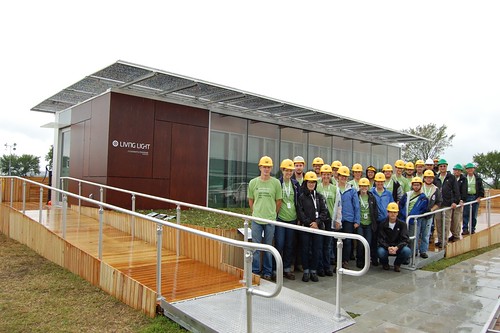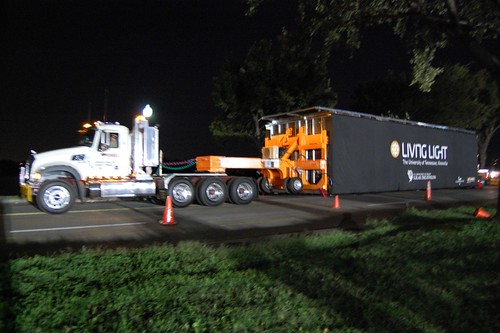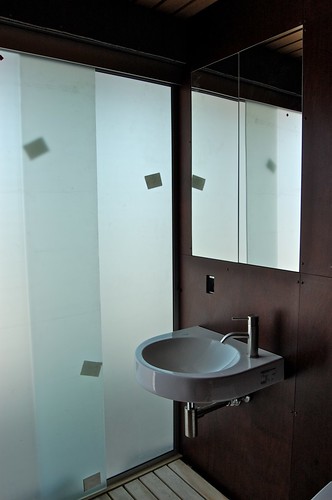(Thanks for this diary. Also check out Solyndra Shakeout Seen as a Sign of Success for Wider Solar Market. As usual, the media and right-wing politicians are totally wrong. – promoted by lowkell)
While  members of Congress are raising h-ll about the Solyndra bankruptcy along with many who are forgetting that they once touted Solyndra as the future, just a little distance away, Solandra technology is powering an absolutely gorgeous home available for public visit for the coming two weeks.
members of Congress are raising h-ll about the Solyndra bankruptcy along with many who are forgetting that they once touted Solyndra as the future, just a little distance away, Solandra technology is powering an absolutely gorgeous home available for public visit for the coming two weeks.
This house, the University of Tennessee’s Living Light, is part of one of the nation’s most important (and sadly too little discussed) intercollegiate competitions is about to open in Washington, DC: the biennial Solar Decathlon. Opening to the public 23 September, the Decathlon brings together 19 university teams from around the globe to compete across ten categories (thus, “decathlon”). After having reviewed all the Solar Decathlon entries, this post will look more closely at Living Light.
Living Light is a very high-quality efficiency house whose  form is inspired by the cantilever barns of southern Appalachia. In terms of actual living space, this is one of the smallest (if not smallest homes) because of the team’s intent: they will take Living Light on a tour throughout Tennessee, showing the reality of the promise of solar technology. Thus, this is designed to be easily transported (with the direct living space transported on one truck and additional transport for elements like decks and spare solar tubes. Along with more solar electricity capacity than required to meet the house’s actual needs (and thus power production that will help boost competitive positioning re electricity production), this design element helped push up the unit’s price.
form is inspired by the cantilever barns of southern Appalachia. In terms of actual living space, this is one of the smallest (if not smallest homes) because of the team’s intent: they will take Living Light on a tour throughout Tennessee, showing the reality of the promise of solar technology. Thus, this is designed to be easily transported (with the direct living space transported on one truck and additional transport for elements like decks and spare solar tubes. Along with more solar electricity capacity than required to meet the house’s actual needs (and thus power production that will help boost competitive positioning re electricity production), this design element helped push up the unit’s price.
This design has many notable features. In terms of interior design space,  my family loves the quality of finish and my children, on seeing the video’s discussion of how the kitchen and other elements can be masked (see below), separately exclaimed “Mom would love that.” Walking into Living Light, the quality of finish jumped out … the cabinetry was well designed, beautiful wood, and extremely well executed. The bed pulls out, kitchen gets covered, etc with an ease that comes with great workmanship. Combining the designed focus on easy transportability for showcasing solar power and seeing that quality, it didn’t surprise me that Living Light was the first Decathlete house to pass its inspections and be certified for public visits.
my family loves the quality of finish and my children, on seeing the video’s discussion of how the kitchen and other elements can be masked (see below), separately exclaimed “Mom would love that.” Walking into Living Light, the quality of finish jumped out … the cabinetry was well designed, beautiful wood, and extremely well executed. The bed pulls out, kitchen gets covered, etc with an ease that comes with great workmanship. Combining the designed focus on easy transportability for showcasing solar power and seeing that quality, it didn’t surprise me that Living Light was the first Decathlete house to pass its inspections and be certified for public visits.
In terms of technology, Living Light stands out for its smart facade. Living Light’s North-South walls are a dynamic double façade system made of alternating translucent and transparent panes and horizontal blinds. These work automatically with an energy recovery system to cool in summer and heat in the summer with great efficiency.
a motorized horizontal blind system which blocks solar radiation/sunlight before it reaches the conditioned space. The blind system will be programmed to provide proper lighting and shading throughout the year. It also provides privacy when desired. Heat that is harvested within the double façade system will be directed to an energy recovery ventilator, supplying the home with preheated air. When the outside temperature and humidity are acceptable, the operable panels allow outside air into the house. The outer pane of glass also reduces the wind load on the house thus reducing unwanted infiltration and allowing the blinds to be deployed under any weather condition.
Not highlighted is a truly desirable feature. When I visited the house, the neighboring area was filled with noise as the teams rushed to finish their homes. Inside Living Light, almost total silence with no sounds intruding on conversation with UT team members.
As with Penn State’s 2009 Decathlon entry, Natural Fusion, the 2011 University of Tennessee team chose to use Solyndra solar electricity tubes as their solar power generation system.  The Solyndra tubes remain a truly innovative approach to electricity production, enabling capturing sunlight across a 360° surface and convert it to electricity. Thus, even indirect and reflected light become meaningful for the home’s power production. While the University of Tennessee team almost certainly wishes to receive attention for other reasons, Living Light’s deployment of Solyndra tubes demonstrates, in a quite tangible level amid the Solyndra ‘scandal’,, that this technology works effectively to produce power even as business condition changes (mainly due to massive PRC investments in solar technology production) have driven the company out of the market.
The Solyndra tubes remain a truly innovative approach to electricity production, enabling capturing sunlight across a 360° surface and convert it to electricity. Thus, even indirect and reflected light become meaningful for the home’s power production. While the University of Tennessee team almost certainly wishes to receive attention for other reasons, Living Light’s deployment of Solyndra tubes demonstrates, in a quite tangible level amid the Solyndra ‘scandal’,, that this technology works effectively to produce power even as business condition changes (mainly due to massive PRC investments in solar technology production) have driven the company out of the market.
Understanding the planned showcasing of Living Light across Tennessee, the price issue creates a fundamental challenge. This is an efficiency; an extremely attractive, very well finished, with innovative technology efficiency. Considering the estimated $400,000 price tag before considering land/such costs, I have a hard time seeing the market position for this house. Yet, that might represent my limitations and difficulties in embracing the team’s vision: to “challenge the way we think about a traditional home, adopting a loft like space in a stand-alone home.”
Related: See the UT Zero site.
Posts on 2011 Solar Decathlon:
- Bright Rays of Sunshine Hit DC: A preview of The Solar Decathlon Provides an overview of each of the 19 teams.
- A CHIP Shot at a Better Future? discussing the SCI-ARCH/CALTECH 2011 entry.
- Hot DC Solar Weeks highlighting a number of DC-area solar-events, including the Solar Decathlon
- A peek at solar decathletes … open to the public in DC through 25 July 2010 … looking at the decision to move the Solar Decathlon off the Mall between the Congress and the Washington Monument (which was later followed by the decision to locate it by the Martin Luther King Memorial in Potomac Park)
- Department of Interior Exiles Innovation
discussing the situation to move the Solar Decathlon away from the National Mall
Posts on 2009 Solar Decathlon:
Discussions of houses
- German Solar Rides Power Surge to a Win which discusses the winning home, structure of the Decathlon scoring that enabled them to win, and thoughts about how to move forward.
- A Solar Decathlon Cheat Sheet (overview of the 20 homes and links to home web sites)
- The NORTHern Sun Hits The Mall
- A corner of The National Mall is s•ky blue
- Showing some CURIOsity at The Mall
- Cash is Green
- A Napa Valley Vision on The National Mall
- An ICON-ic statement about a better future
- An Illuminating Vision for Pavilion Living: VT’s Lumenhaus
- Penn State’s Natural Fusion
- Something old, Something New: A Gable on the Mall
Overview of Decathlon / policy / framing / discussion



![Monday News: Trump’s Lunacy Pushes China, Russia, India, etc. Together; “Happy Labor Day. Donald Trump and Elon Musk Are Screwing Workers.”; “Where is the [media’s] intense focus on Trump’s failing health?”; ““Trump says he is not a dictator. Isn’t he?”](https://bluevirginia.us/wp-content/uploads/2025/09/montage0901-238x178.jpg)










![Monday News: Trump’s Lunacy Pushes China, Russia, India, etc. Together; “Happy Labor Day. Donald Trump and Elon Musk Are Screwing Workers.”; “Where is the [media’s] intense focus on Trump’s failing health?”; ““Trump says he is not a dictator. Isn’t he?”](https://bluevirginia.us/wp-content/uploads/2025/09/montage0901-100x75.jpg)